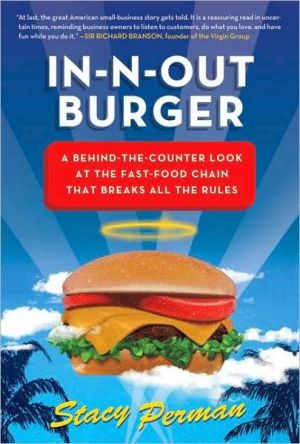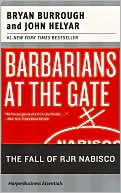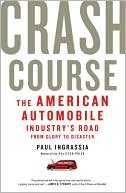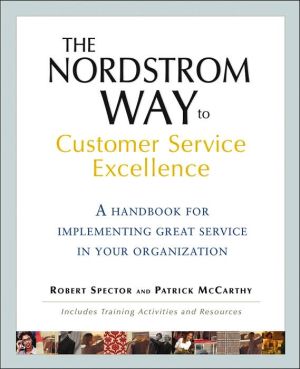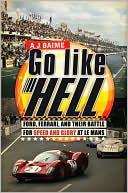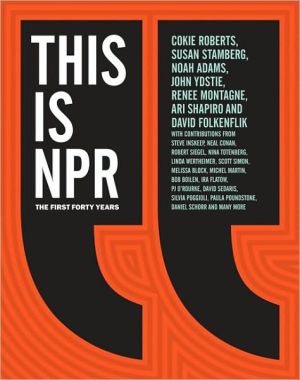In-N-Out Burger: A Behind-the-Counter Look at the Fast-Food Chain That Breaks All the Rules
The untold story of the renegade burger chain that evokes a passionate following unlike any other\ \ In fast-food corporate America, In-N-Out Burger stands apart. Begun in a tiny shack in the shadow of World War II, this family-owned chain has steadfastly refused to franchise or be sold. It is a testament to old-fashioned values and reminiscent of a simpler time when people, loyalty, and a freshly made, juicy hamburger meant something. Over time, In-N-Out Burger has become nothing less...
Search in google:
The untold story of the renegade burger chain that evokes a passionate following unlike any other In fast-food corporate America, In-N-Out Burger stands apart. Begun in a tiny shack in the shadow of World War II, this family-owned chain has steadfastly refused to franchise or be sold. Over time, In-N-Out Burger has become nothing less than a cultural institution that can lay claim to an insanely loyal following. Stacy Perman's In-N-Out Burger is the inside story behind a real American success story—not only a tale of a unique and profitable business but also of a family's struggle to maintain a sustainable pop empire against the industry it helped pioneer. A keenly observed narrative that explores the transformation of a California fad into an enduring cult of popularity, it is also the story of the conflicted, secretive, and ultimately tragic Snyder family, who cooked a billion burgers and hooked a zillion fans. Publishers Weekly Perman (Spies Inc.) casts an affectionate and admiring eye at In-N-Out Burger, the family-owned, Southern California chain that has become a "cultural institution" without franchising, going public, changing its menu or precooking its burgers. This book traces the history of the company and the Snyders, the family that founded and still owns In-N-Out, interspersed with the evolution of the fast-food industry. Perman never makes good on her promise to go "behind-the-counter" and analyze the company's dealings-her access to executives and family members did not extend to gleaning financial or strategic information-consequently it's never clear whether In-N-Out's conservatism is a conscious business strategy, a personal preference of the owners or plain complacency. More a glowing fan letter from an appreciative customer than exposé, this book has more to say about the company's celebrity fans, American family dynamics and our collective love affair with fast food. (Apr.)Copyright © Reed Business Information, a division of Reed Elsevier Inc. All rights reserved.
In-N-Out Burger\ A Behind-the-Counter Look at the Fast-Food Chain That Breaks All the Rules\ Chapter One\ The old In-N-Out Burger stand—a simple red brick structure with a twin-lane drive-through—today stands empty. Occupying a quiet lot on the corner of Francisquito and Garvey avenues in Baldwin Park, "Number One" (as it is commonly known) is surrounded by asphalt and bordered by a short row of windowless, single-story warehouses. Hemmed in on one side by the Interstate 10 freeway and a shopping complex anchored by a giant Target Center on the other, the site of the first In-N-Out is part of history now, closed off to the public by a wrought iron fence, where neat beds of white flowers grow between the bars.\ At one time, on a sliver of the quarter-acre property, there was a pet shop that sold exotic birds. From the start, Harry Snyder was a man who knew how to maximize his opportunities, and oftentimes the company would lease out the unused space at various In-N-Out properties. The small shack nearly hugging the freeway ramp is still there, but it is vacant now. Its weathered green exterior is peeling and the painted lettered sign that reads "Birds Us" is still visible, although it too has been faded by time.\ Directly across the street from the original store Number One is a large, empty patch of land, a circular expanse of dry earth and scrub weeds enclosed by the curving sweep of the freeway on-ramp. At one time it was home to one of Baldwin Park's most popular trailer parks. And beyond, fanning out from Garvey Avenue, is a washed-out pink apartment building and a cluster of small ranch houses. Like the shuttered Number One, thescene is a reminder of Baldwin Park as it was before it became just another drowsy suburb of Los Angeles, when its farms and ranches were carved up, sold, and paved over in the postwar boom to make way for the eventual chain stores, strip malls, and tract houses built in their place.\ But in 1948, this was the frontier of the American dream. This was where newly married ¬couples like Harry and Esther Snyder could purchase a spit of land, buy a small house, build an even smaller burger joint—and dream big dreams. Postwar Baldwin Park was the promised land of the working class. Baldwin Park is the spot where In-N-Out Burger began. And it is where the Snyders developed their basic philosophy: serve the freshest, highest-quality burgers and fries; treat your employees well and your customers even better, all while providing friendly ser¬vice in a spanking clean environment; and above all, remain family-owned and independent. That philosophy was the starting point for what would become the fast-food industry. And even as In-N-Out's competitors later raced around the globe, franchising identical box-like fast-food stores on rows of identical strip malls in nearly identical towns, In-N-Out never wavered from that simple philosophy.Across from the old lot on Francisquito Avenue, on the south side of the freeway, stands the new model, single-lane drive-through "Number One." Opened in 2004, In-N-Out's hometown flagship is actually the third of the chain's Number Ones. In 1954, when the state of California expanded the Interstate 10, a stretch of the new freeway came straight up Garvey Avenue, cutting right through the first store—so the Snyders tore down the stand and rebuilt their second "Number One" several feet away.\ Every day, hundreds of motorists whiz by the vacant "Number One" on Francisquito. They are easily confused by the low-hung In-N-Out sign out front. Many mistakenly attempt to turn into the lot before being abruptly confronted with the locked iron gate. Occasionally, however, when the gate is open and nobody is watching, it is possible to steal onto the property and glimpse the spot where In-N-Out began. Baldwin Park's "old-timers," as they like to call themselves—those folks who've lived here since that first In-N-Out opened—insist that despite its enormous success, not much has changed. "Those burgers taste exactly the same as day one," they chorus.\ Looking around, it is almost possible to conjure up those early days when the area was just dirt roads and open fields and In-N-Out's dusty lot was filled with teenagers and their hot rods. Glimpsed through the large glass windows, the open kitchen remains largely intact. The single grill, despite its long retirement, is scrubbed clean and free of grease. The stainless steel beverage dispenser still has paper cups with the familiar red palm tree motif stacked up inside like Russian matryoshka dolls. And the old analog clock tower with the now famous In-N-Out logo, a bright yellow neon boomerang arrow, still keeps time as it clears the grey concrete slab of freeway that slices through the sky behind it.\ That original In-N-Out Burger was once immortalized in a Jack Schmidt painting, reproduced later by the company on T-shirts and postcards; in its portrait, the squat little box of a stand with its red and white awning is offset by a blue sky filled with cumulus clouds. The snow-capped San Gabriel Mountains are in the distance, as are a handful of ranch houses. A parade of old Studebakers with their curved, single-pane windshields, sloped backsides, rear fender skirts, and fat white rim tires are lined up on the gravel drive-through lane. One motorist is shown placing an order in front of a small white box on a pole with the words "Two Way Speaker" written across the side in red letters. And manning the grill inside the open kitchen window is a smiling young man in a crisp white shirt and a paper cadet hat. There is talk that the original site depicted in that postcard will eventually be turned into an In-N-Out museum or that the old kitchen will be donated to a historical society, but nobody knows for certain.\ In-N-Out Burger\ A Behind-the-Counter Look at the Fast-Food Chain That Breaks All the Rules. Copyright (c) by Stacy Perman . Reprinted by permission of HarperCollins Publishers, Inc. All rights reserved. Available now wherever books are sold.
\ San Francisco Mayor Gavin Newsom“When fast food restaurants tried to locate in Fishermans Wharf, ourlocal merchants were opposed to every one of them—except In-N-Out.Because every meal is fresh and made from scratch, In-N-Out is in aclass by itself.”\ \ \ \ \ Fortune Small Business“Stacy Perman’s illuminating new book, In-N-Out Burger, is an absorbing case study of how a family business came to be at the center of its own cheerful cult.... [This] should be required reading for family business owners, alongside Rich Cohen’s Sweet and Low and Thomas Mann’s Buddenbrooks.”\ \ \ Publishers WeeklyPerman (Spies Inc.) casts an affectionate and admiring eye at In-N-Out Burger, the family-owned, Southern California chain that has become a "cultural institution" without franchising, going public, changing its menu or precooking its burgers. This book traces the history of the company and the Snyders, the family that founded and still owns In-N-Out, interspersed with the evolution of the fast-food industry. Perman never makes good on her promise to go "behind-the-counter" and analyze the company's dealings-her access to executives and family members did not extend to gleaning financial or strategic information-consequently it's never clear whether In-N-Out's conservatism is a conscious business strategy, a personal preference of the owners or plain complacency. More a glowing fan letter from an appreciative customer than exposé, this book has more to say about the company's celebrity fans, American family dynamics and our collective love affair with fast food. (Apr.)\ Copyright © Reed Business Information, a division of Reed Elsevier Inc. All rights reserved.\ \ \ \ \ Library JournalIn-N-Out Burger is a regional hamburger chain (California, Arizona, Nevada, and Utah) with a cult following. The chain is known for its eccentricities-e.g., a secret menu and tiny Bible verses printed on almost everything-but its strangeness contributes to its appeal. In this dense history, Perman (Spies, Inc.: Business Innovation from Israel's Masters of Espionage) follows three generations of the Snyder family as they expand their business from a hot dog stand to a chain found in 200 locations. Perman lays the groundwork for contrasting family-owned In-N-Out with megacorporation McDonald's, but this appealing theme simply disappears. Founder Harry Snyder was simultaneously a fast-food innovator (he invented the two-way speaker box) and a micromanaging Luddite who seemingly succeeded in spite of himself by being in the right place at the right time. As Perman details two more generations of family dysfunction, her dry tone keeps the reader from the more engaging episodes. Interest in this sometimes plodding text will be proportionate to the reader's affinity for the brand. Recommended for local devotees of the chain and for some readers in American popular culture.\ —Robert Perret\ \ \ \ \ \ Time magazine“[An] entertaining corporate history....Perman’s reporting is considerable.”\ \ \ \ \ Fortune Small Business"Stacy Perman’s illuminating new book, In-N-Out Burger, is an absorbing case study of how a family business came to be at the center of its own cheerful cult.... [This] should be required reading for family business owners, alongside Rich Cohen’s Sweet and Low and Thomas Mann’s Buddenbrooks."\ \ \ \ \ Jane and Michael Stern“Thanks to Stacy Perman’s book, the term ‘soulful fast food’ is no longer an oxymoron. Her recounting of the In-N-Out story is one of passion, good intentions, remarkable success and treachery that transcends the burger world to become a tale that is vivid Americana.”\ \ \ \ \ George Motz"Did you ever wonder why the people behind the counter at In-N-Out are always smiling? Now I know thanks to Stacy’s amazing book."\ \ \ \ \ Time Magazine"[An] entertaining corporate history....Perman’s reporting is considerable."\ \ \ \ \ Sir"At last, the great American small business story gets told. It is a reassuring read in uncertaintimes, reminding business owners to listen to customers, do what you love, and havefun while you do it."\ \ \ \ \ Mario Batali"This book grills up an enjoyable read for both avid foodies and novice diners alike! Perman’s sneak peek into the fascinating history of In-N-Out is as good as the delicious burgers themselves, and that’s saying a lot!"\ \ \ \ \ Gavin Newsom"When fast food restaurants tried to locate in Fishermans Wharf, ourlocal merchants were opposed to every one of them—except In-N-Out.Because every meal is fresh and made from scratch, In-N-Out is in aclass by itself."\ \ \ \ \ Andrew F. Smith" Wow! Stacy Perman’s In-N-Out Burger isn’t just a good book about the rise of a fast-food chain—it’s an exciting saga about a family who created a profitable company that serves great food and still treats its customers and employees decently. What a great story!"\ \ \ \ \ Tilar J. Mazzeo"The tumultuous history of how one family and the business they fought to control turned the hamburger into the culinary symbol of a century....Told with the same fresh approach that has turned In-N-Out Burger into an American institution, Perman keeps us wanting more."\ \
